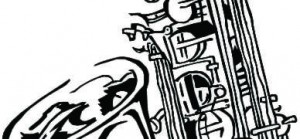Protected: Saxophone Practice Challenge – Day 26
Protected: Saxophone Practice Challenge – Day 25
Do You Think About Your Saxophone More Than You Play It?
Some sax players spend an inordinate amount of time thinking about equipment…..
Tiger Woods would still beat you at golf if he used crappy clubs.
But maybe not if he used a baseball bat and a volleyball.

So have make sure your saxophone, mouthpiece, reeds, etc are functioning. But DO NOT spend more time worrying about your equipment than actually playing & practicing.
The saxophone itself has a body and a neck. The mouthpiece goes on the neck and has a reed held on by a ligature. The mouthpiece, reeds, and ligature matter sometimes more than the horn itself.
Saxophone Reeds
The reed makes the sound in your saxophone through its vibration.
Saxophone reeds are made of a special cane that grows in only a few parts of the world. It is expensive and wears out in a few weeks. There are synthetic alternatives, but they don’t sound as good.
Start with a softer reed (lower number). And you’ll also want a softer reed if you have a mouthpiece that is more open. Beginners can start with number 2 and experiment from there.
Saxophone Mouthpiece
The basic idea of mouthpiece position on a sax is that pushing the mouthpiece farther down on the cork will make your intonation higher while pulling it out will make your intonation lower.
To quote Jimmy Haag, “You are basically playing a long tube when you play a saxophone. Saxophone is all about the speed of the air like any wind instrument. The length of the tube determines its harmonics. Since EVERYONE has a different throat, mouth, teeth, and tongue, it is a truly individual journey to find out what works for you. I meet a lot of people who are looking for a standard but in fact there is only one way that will work for you.”
So it’s not as simple as pushing the mouthpiece on farther or pulling it out more.
The temperature and the environment affect intonation too- if it’s hot outside the air will move faster and the sax will be sharper, if its cold- it will tend to be flat.
And a saxophone in tune on one note will not necessarily be in tune on another note, if not adjustments are made by the player. With practice, you’ll develop control and these things will happen subconsciously.
Ligature
The ligature holds the reed on the saxophone mouthpiece. It makes some differences. But you probably don’t need to spend ridiculous amounts of money on a diamond encrusted ligature.
Saxophone
There are four ‘big’ brands of saxophone:
Selmer, Keilwerth, Yamaha, and Yanagisawa.
They all make professional horns.
The Selmer Mark VI is the most famous type of saxophone, they stopped making them, so the Mark VI’s can be very pricey these days. But many professionals swear by them. Not every Mark VI is still in great condition though.
There are some other brands that make decent horns. Be careful if they are imported and have soft metal. And try them out before you buy them.
Saxophones have features such as rolled tone holes and a high F# key. In general many of the advancements in instrument making have been adopted by most saxophone companies.
Types of Saxophone
When you’re starting off, play an alto or tenor. Alto’s a bit smaller and easier for a child to carry.
Soprano is smaller than alto, but its tone is harder to control.
And baritone is larger than tenor.
Tenor saxophone is what most famous saxophone players favor although some preferred alto and there are a handful of saxophone players who mostly play soprano or bari.
Musicality!
Remember that you need to play music on your saxophone, not just have nice equipment.
A bad driver in a Ferrari is not impressive.
Sometimes problems you have with playing are actually because of the instrument, reed, etc. But more times they are not.
Protected: Saxophone Practice Challenge – Day 24
Protected: Saxophone Practice Challenge – Day 23
Street Saxophone!
In Santa Cruz the other day I saw a street saxophone player again.
I had seen him before walking along and playing an alto.
This time he had a tenor and I commented on that.
He heard me say something and asked if I played.

Found out his name was Peter and he invited me to jam on the street sometime.
Could be interesting.
Saxophone Practice Challenge – Day 22
Saxophone Practice Challenge
Saxophone Phrasing
When you speak, if you phrase something a certain way it changes the meaning.
Sometimes by a lot.
Phrasing while you’re playing your saxophone can also have a big impact.
So you can change the sound of a song by changing what you feel.
Part of phrasing is determined by what you play during one breath. As saxophone players we need to breath with the music (as opposed to say guitar/bass/piano) so that can help.
Phrasing on saxophone is also how you start and end ideas and how you express them in them in the middle too.

Learning Saxophone
Tip – Start developing your phrasing on sax by listening to how other musicians- sax players, other horn players, singers, etc. phrase the music they play.
Mindset Lesson–:
Phrasing is somewhat more advanced an element to be working on. So get the basics first. But it can’t hurt to have it in mind as you play even early on.
Protected: Saxophone Practice Challenge – Day 21
Saxophone Practice Challenge – Day 20
Saxophone Challenge
Saxophone Feeling & Emotions
If your dog just died, the way you play “Blue Skies’ by Irving Berlin probably will not be especially cheerful.
Feelings and emotions come through your saxophone to the listener!
So you can change the sound of a song by changing what you feel.
Being able to convey emotions and feeling to your audience is an important part of forming a connection through your music.
It gives music part of its soul.

Tip – Think about what feelings you think a song has in it and how you can show them musically.
Mindset Lesson–:
A musician with feeling may connect with the audience pretty well based on that one element. Enough that they will ignore shortcomings in technique and other areas. So don’t be a saxophone robot!
Protected: Saxophone Practice Challenge – Day 19


